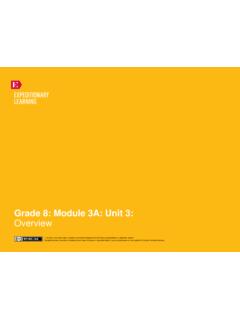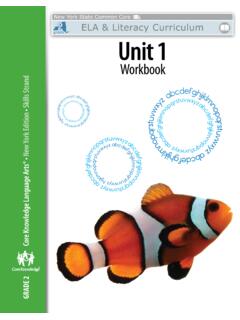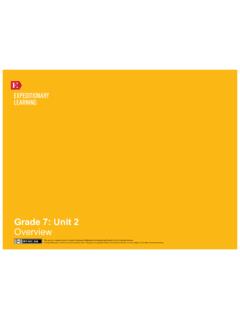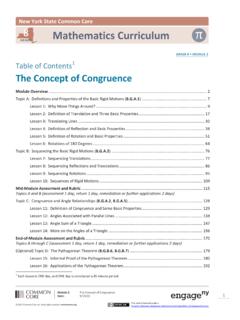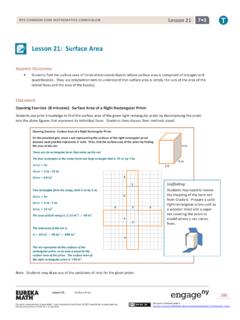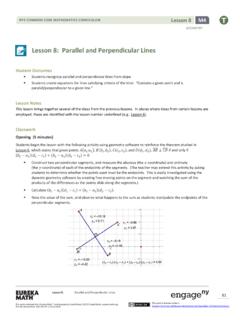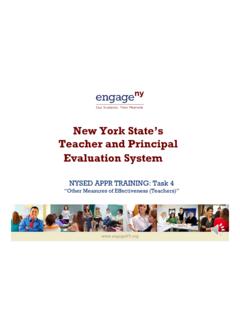Transcription of Grade 7: Module 3A: Unit 1: Lesson 3 Building …
1 Grade 7: Module 3A: unit 1: Lesson 3 Building Context for the Narrative: Slavery in America This work is licensed under a Creative Commons Attribution-NonCommercial-ShareAlike Unported License. Exempt third-party content is indicated by the footer: (name of copyright holder). Used by permission and not subject to Creative Commons license. Grade 7: Module 3A: unit 1: Lesson 3 Building Context for the Narrative: Slavery in America Long-Term Targets Addressed (Based on NYSP12 ELA CCLS) I can cite several pieces of text-based evidence to support an analysis of informational text. ( ) I can accurately use 7th Grade academic vocabulary to express my ideas. ( ) Supporting Learning Targets Ongoing Assessment I can draw conclusions about slavery in America and cite specific textual evidence to support them.
2 Slave Trade Text Dependent Questions Created by Expeditionary Learning, on behalf of Public Consulting Group, Inc. Public Consulting Group, Inc., with a perpetual license granted to Expeditionary Learning Outward Bound, Inc. NYS Common Core ELA Curriculum G7:M3A:U1:L3 November 2013 1 Grade 7: Module 3A: unit 1: Lesson 3 Building Context for the Narrative: Slavery in America Agenda Teaching Notes 1. Opening A. Reviewing Homework and Learning Targets (5 minutes) 2. Work Time A. Images: Encountering Slavery in America (15 minutes) B. Close Reading: The Slave Trade (20 minutes) 3. Closing and Assessment A. Turn and Talk (2 minutes) B. Previewing Homework (3 minutes) 4. Homework A. Read the text on abolition and answer text-dependent questions.
3 PBS produced a series entitled Freedom: A History of US. Each episode on the video has an accompanying webisode, which is a combination of text and images, not another video. Lessons 3, 4, and 5 all rely on texts from Webisode 5: A Fatal Contradiction. Those texts are included with the supporting materials. The lessons also provide a time for students to work with images and/or video that relate to the texts they read. Encountering the material through multiple media will increase student engagement and deepen their understanding. If you have access to the PBS video (and specifically to Episode 5: A Fatal Contradiction ) consider showing clips of this video instead of doing the work with images in these lessons.
4 The clips from the video that are relevant to this Lesson and could be used in Work Time A are: The Slave Trade, and Plantation Slavery (2:45 8:55) . If you choose to use the video instead of the work with images, adapt the worksheet to provide students with a place to take notes on the three focusing questions as they watch the video. In Work Time A, students work with four images about slavery from the website Freedom: A History of US. The images can be found at You will look at: Slave ship, A Virginia slave group, Slaves in a cotton field, and A slave s whip marks. Detailed directions for finding these images are on the Analyzing Images: Slavery in America handout. Depending on your access to technology, you can either have students look at these images on line (the worksheet they use has directions for finding the images) or you can display them for the whole class.
5 In either case, students should discuss the images with a partner before a short whole-class debrief. These lessons deal with slavery in America. Be prepared to help students process the violence of this time. Also, many students will have questions about the ways in which American slavery was different from slavery in other places, and the role that race played in the evolution of the institution of slavery. An excellent resource to build your own background knowledge about these issues is the PBS series Africans in America. Created by Expeditionary Learning, on behalf of Public Consulting Group, Inc. Public Consulting Group, Inc., with a perpetual license granted to Expeditionary Learning Outward Bound, Inc.
6 NYS Common Core ELA Curriculum G7:M3A:U1:L3 November 2013 2 Grade 7: Module 3A: unit 1: Lesson 3 Building Context for the Narrative: Slavery in America Agenda Teaching Notes (continued) This Lesson begins a series of three lessons focused on Students read and analyze informational texts, citing textual evidence to support their thinking. They build their understanding of slavery, abolition, and the life of Douglass and hold these ideas on an anchor chart. Understanding this period in American history will be essential as they read Narrative of the Life of Frederick Douglass later in this unit . For homework, students read a text about abolition and answer text-dependent questions. This text will be reviewed and reinforced in Lesson 4.
7 There is an optional scaffolded version of the text for struggling readers who need vocabulary support. In advance: Read The Slave Trade and Abolition texts from Freedom: A History of US, Webisode 5 A Fatal Contradiction. Decide how you will share the images related to slavery with students. Review Equity Sticks Guidelines and make equity sticks (see supporting materials). Decide which students may need Abolition text from Freedom: A History of US, Webisode 5: scaffolded version. Post: Answers for Vocabulary Homework, learning target, and Slave Trade Text-Dependent Questions. Created by Expeditionary Learning, on behalf of Public Consulting Group, Inc. Public Consulting Group, Inc., with a perpetual license granted to Expeditionary Learning Outward Bound, Inc.
8 NYS Common Core ELA Curriculum G7:M3A:U1:L3 November 2013 3 Grade 7: Module 3A: unit 1: Lesson 3 Building Context for the Narrative: Slavery in America Lesson Vocabulary Materials equity, conclusions, evidence, cite, triangular slave trade, system, enforced labor, plantation, crops Equity Sticks Guidelines (for teacher reference; see supporting materials) Answers for Vocabulary Homework (one to display) Equity sticks Historical Context anchor chart (begun in Lesson 2) Analyzing Images: Slavery in America (one per student and one to display) Four images about slavery in America (see teaching notes) Vocabulary: The Slave Trade and Abolition (from Lesson 2) The Slave Trade text from Freedom: A History of US, Webisode 5 (one per student) Document camera The Slave Trade Text-Dependent Questions (one per student) The Slave Trade Close Reading Guide (for teacher reference) Abolition text from Freedom: A History of US, Webisode 5 (one per student) Abolition text from Freedom: A History of US, Webisode 5.
9 Scaffolded version (optional; for students needing additional support) Abolition Text-Dependent Questions, Part 1 (one per student) Abolition Text-Dependent Questions, Part 1 (answers, for teacher reference) Created by Expeditionary Learning, on behalf of Public Consulting Group, Inc. Public Consulting Group, Inc., with a perpetual license granted to Expeditionary Learning Outward Bound, Inc. NYS Common Core ELA Curriculum G7:M3A:U1:L3 November 2013 4 Grade 7: Module 3A: unit 1: Lesson 3 Building Context for the Narrative: Slavery in America Opening Meeting Students Needs A. Reviewing Homework and Learning Targets (5 minutes) Review the Equity Sticks Guidelines with students. Tell students you will use these sticks to call on students to participate during class, especially when asking them to share out after a period of individual or pair work.
10 Ask students to raise their hands if they know what equity means or if they can think of a word it is related to. Listen for them to refer to something that is equal or fair. Tell them that something that provides equity provides equal or fair access to a resource: In this case, equity sticks help make sure that everyone has a chance to think about questions asked in class and share their thinking. Discuss the importance of being respectful of everyone s learning by pointing out to students that they should not comment if someone needs a moment to think, laugh at others responses, or raise or wave their hands around when others are called on. Direct students attention to the posted Answers for Vocabulary Homework.

